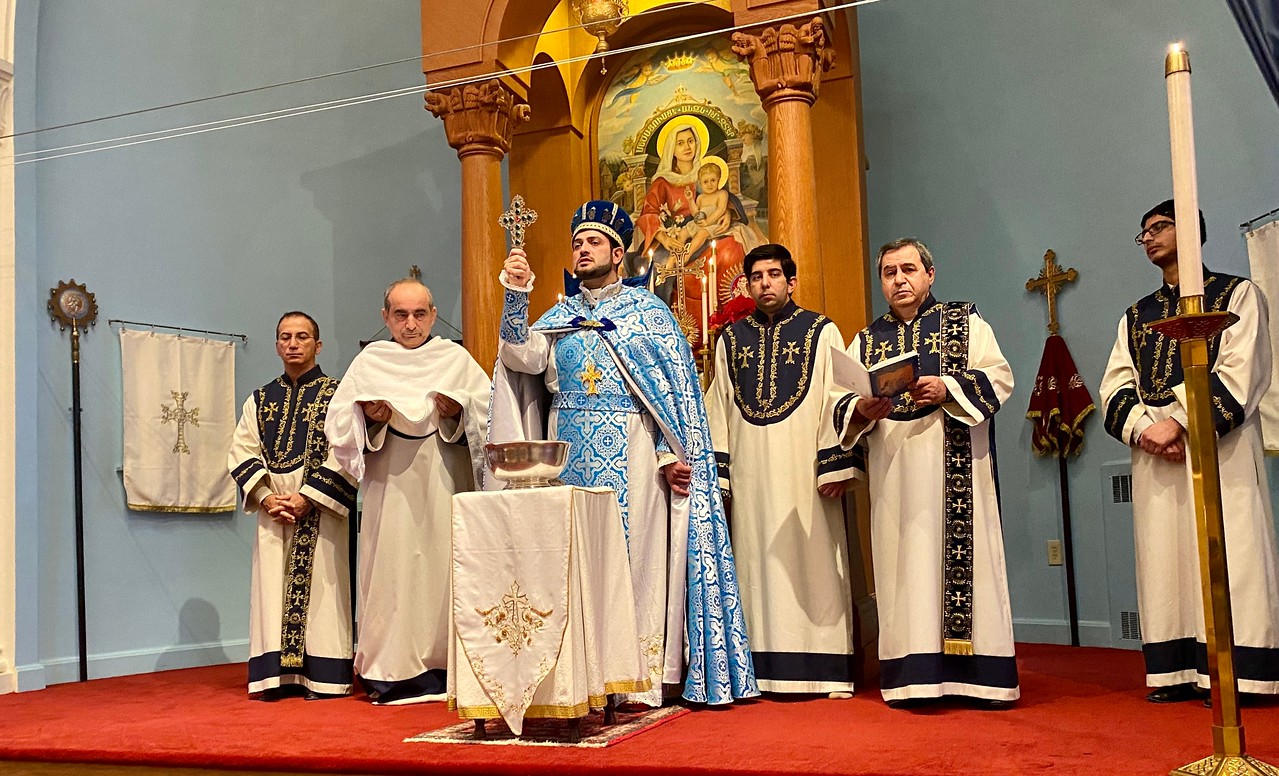
According to our Church Calendar and Traditions on January 6, a Divine Liturgy is celebrated in the Armenian Apostolic Churches, and the “good tidings” is given to everyone: “Christ is born & Revealed – Good Tidings to us All”! The Godfather of the Cross of Godfather of Theophany is chosen in advance. According to the Holy Canons established by our God-fearing holy fathers of the Church, a godfather in the Water Blessing Ceremony symbolically represents St. John the Baptist, who baptized Jesus Christ.
During the Water Blessing Ceremony the Cross is immersed into the water representing the sacrament of the Lord’s baptism. Then the water is blessed with the Cross & Holy Muron-Oil, then the Godfather of Cross of that year holds the cross in a white towel after taking it out of the water. Following the church services everyone approaches to receive the blessings of the Cross and then the Godfather of the Cross, takes the Cross to his home.
On the last day of the Octave of Nativity, on January 13 (or closest feasible day to January 13), the priest visits the house of the Godfather of the Cross, offers a Christmas Home Blessings and returns the cross to the church. The tradition of the Godfather is a mystical and beautiful national tradition in the Armenian Church. And, of course, each person is selected for this role with much thoughtfulness and discernment. The role of godfather is given to the family/person, who can serve as a good example or service and dedication for others in the church community.
Each role and position in the Church comes with certain responsibilities. The Godfather of the Cross commits to offer extra help to the pastor for a whole year, to support the church projects and events initiated by the pastor. The Godfather of the Cross is chosen considering his devotion to the church, his ongoing support and commitment to the community, to our homeland Armenia, to the Church and the people.
_______
Ընդունված կարգի համաձայն` հունվարի 6-ին Հայ Առաքելական եկեղեցիներում մատուցվում է Սուրբ և Անմահ Պատարագ, ու տրվում է փրկարար ավետիսը. Քրիստոս Ծնավ և Հայտնեցավ. մեզ և ձեզ մեծ ավետիս։ Տոնի առթիվ նախապես ընտրվում է Սուրբ Ծննդյան կնքահայրը: Սուրբ Եկեղեցու աստվածատես հայրերի հաստատած կանոնների համաձայն` ջրօրհնեքի ժամանակ ընտրվում է կնքահայր, ով խորհրդանշորեն ներկայանում է որպես Ս. Հովհաննես Մկրտիչ, ով մկրտեց Հիսուս Քրիստոսին:
Ջրօրհնեքի ժամանակ Խաչն իջեցվում է ջուրը, ինչը խորհուրդն է Տիրոջ մկրտության։ Ապա ջուրն օրհնվում է Ս. Խաչով և Մյուռոնով, այնուհետև տարվա խաչքավորը, խաչը ջրից հանելով, տանում է իր տուն:
Ս. Ծննդյան ութօրեքի վերջին օրը, հունվարի 13-ին, քահանան այցելում է խաչքավորի տուն, օրհնում է տունը և խաչը վերադարձնում եկեղեցի: Խորհդավոր, հայկական ու ազգային է քավորի խորհուրդը հայ եկեղեցում և ընտանիքում ու անշուշտ, այս կոչմանը յուրաքանչյուր մարդ ընտրվում է ոչ պատահականորեն։ Քավորի դերը տալիս են այն ընտանիքին, որը կարող է լավ օրինակ ծառայել մյուսներին:
Յուրաքանչյուր կոչում ունի որոշակի պատասխանատվություն. խաչքավորը պարտավորվում են մի ամբողջ տարի լինել հոգևոր հովվի կողքին և կյանքի կոչել նրա կողմից նախաձեռնած յուրաքանչյուր եկեղեցաշեն ծրագիր: Խաչի քավորին ընտրում են` հաշվի առնելով նրա նվիրվածությունը եկեղեցուն, նրա հայրենասիրությունը, ազնվությունը հայրենքի և մարդկանց նկատմամբ:
